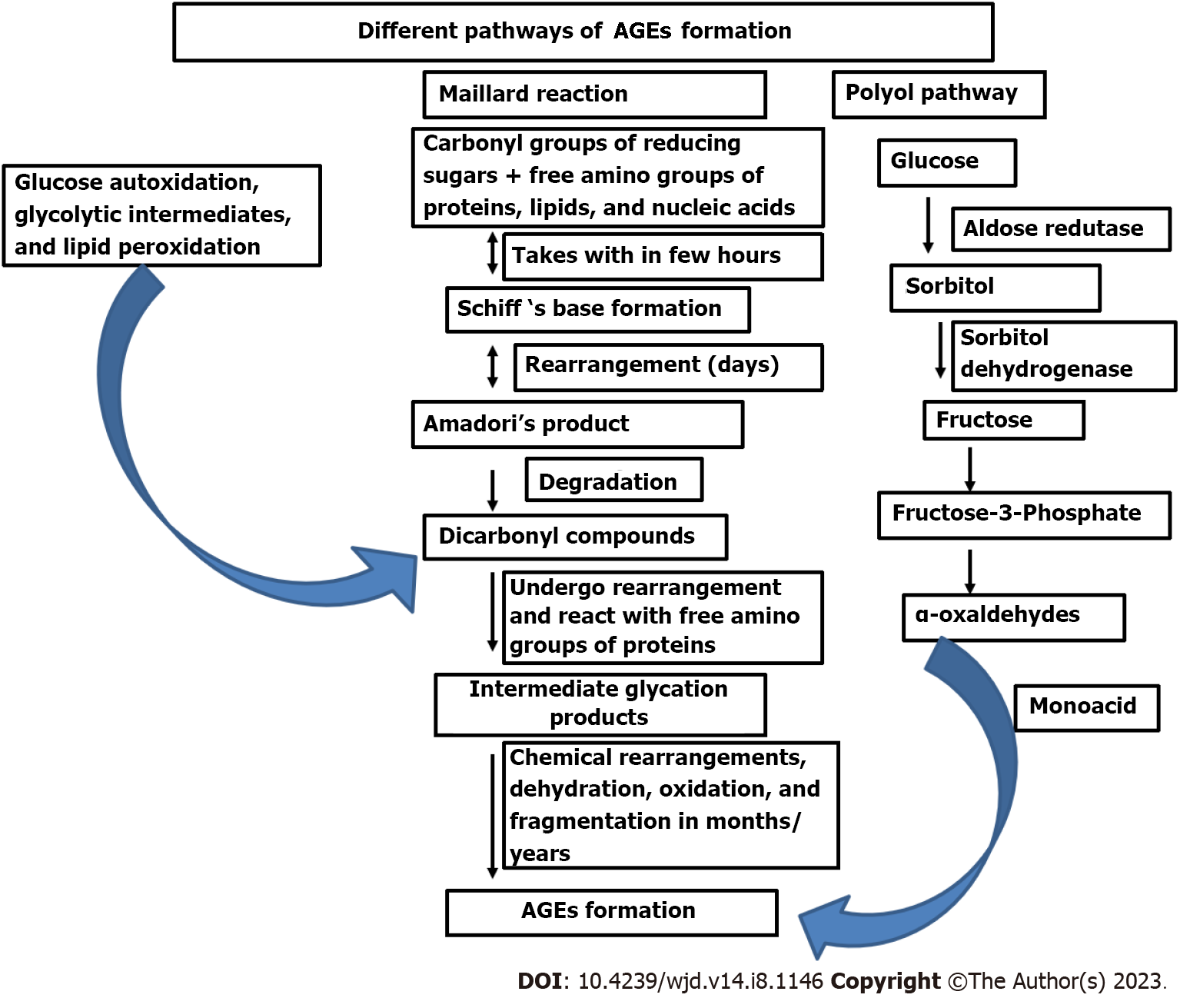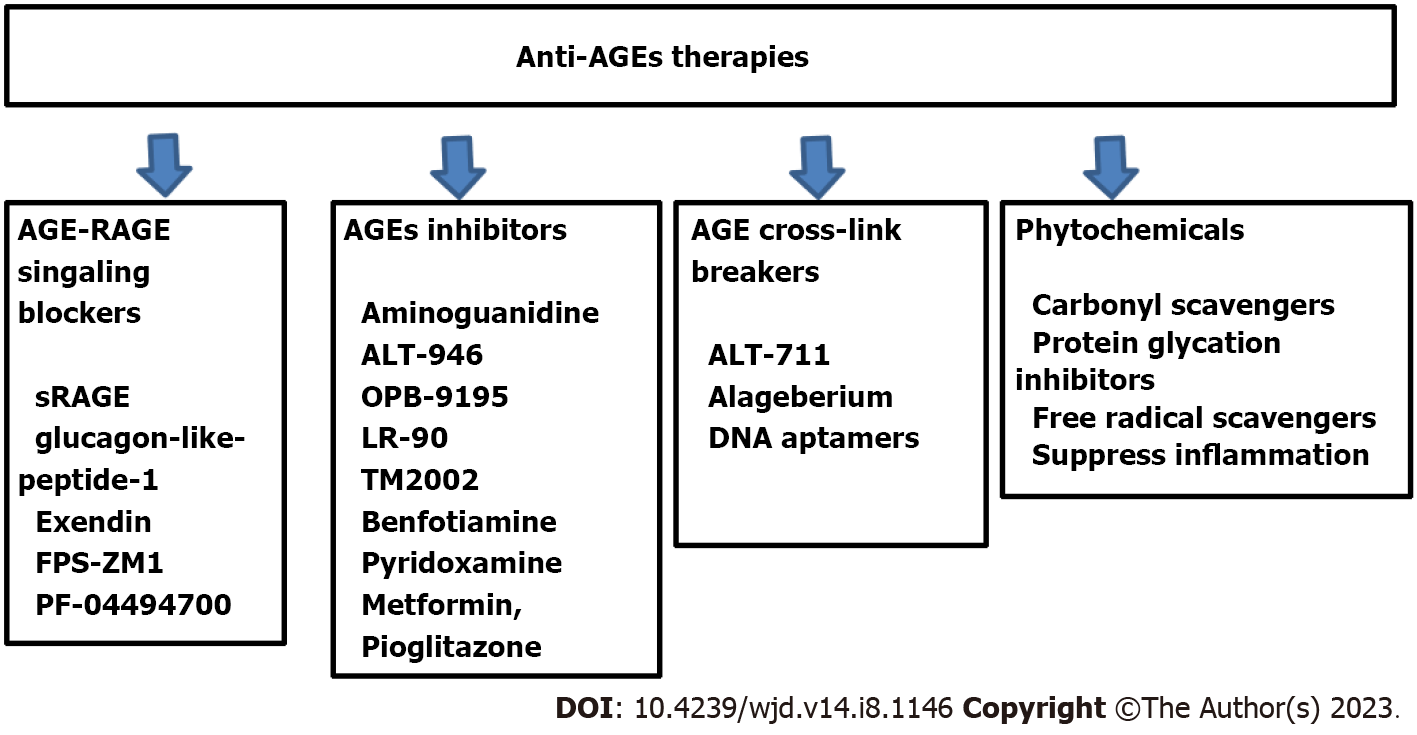Copyright
©The Author(s) 2023.
World J Diabetes. Aug 15, 2023; 14(8): 1146-1162
Published online Aug 15, 2023. doi: 10.4239/wjd.v14.i8.1146
Published online Aug 15, 2023. doi: 10.4239/wjd.v14.i8.1146
Figure 1 Pathways for endogenous advanced glycation end products formation.
Formation of AGEs occurs through different pathways. Maillard reaction which occurs at three stages: (1) Covalent binding of reducing sugars to free amino groups of proteins, lipids, and nucleic acid resulting in reversible Schiff base formation within hours; (2) it undergoes chemical rearrangement over a period of days to form a more stable Amadori product (the reaction is still reversible); and (3) Amadori’s products can be degraded into many reactive dicarbonyl compounds undergoing chemical rearrangements leading to the formation of irreversible AGEs. These spontaneous rearrangements are slow and often taking months to years but enhanced in presence of oxidative stress, and metal ions. Autoxidation of glucose and the peroxidation of lipids into dicarbonyl derivatives also results in AGEs formation. Monosaccharides glycolytic intermediates and dicarbonyl compounds formed during glycolysis also play an important role in AGEs formation. Polyol pathway, where glucose is converted to sorbitol by the enzyme aldose reductase and then sorbitol is converted to fructose by the action of sorbitol dehydrogenase. Fructose metabolites are converted into α-oxaldehydes and interact with monoacids to form AGEs. AGEs: Advanced glycation end products.
Figure 2 Advanced glycation end product-mediated diabetic cardiovascular complications.
AGEs mediate their pathological effects at the cellular and extracellular level by multiple pathways. At the cellular level, they activate signaling cascades via RAGE and initiate a complex series of intracellular signaling leading to reactive oxygen species generation, oxidative stress development, inflammation, adhesion molecule expression, endothelin-1, plasmin activator inhibitor 1, tumor necrosis factor alpha, chemoattraction of inflammatory cells, smooth muscle and fibroblast proliferation, autophagy, and apoptosis. AGE–RAGE interaction modulate the cellular properties through stimulation of signaling molecules such as ERK 1/2, p21RAS, MAPK, NF-B, cdc42/rac, and Janus kinase/STAT and adversely affects the cardiovascular health in diabetes. AGEs also causes covalent modifications and crosslinking of serum and ECM proteins, altering their structure, stability, and functions. Modification of ECM proteins and cross-linking interferes with cell–matrix and matrix–matrix interactions, affecting the matrix–cell signaling and leading to profibrotic action, decreased elasticity, increased stiffness, narrowing of vessels, and other hallmarks of atherosclerosis. VCAM1: Vascular cell adhesion molecules; JAK: Janus kinase; RAGE: Receptor for advanced glycation end products; NADPH: Nicotinamide adenine dinucleotide phosphate oxidase; NF-κB: Nuclear factor-B; AGEs: Advanced glycation end products; MAPK: Mitogen-activated protein kinase; ROS: Reactive oxygen species; TNF-α: Tumor necrosis factor ; ERK: Extracellular signal-regulated kinase; LDL: Low-density lipoprotein; ECM: Extracellular matrix.
Figure 3 Anti-advanced glycation end product therapeutic strategies.
Anti-AGE therapies target multiple pathways based on AGE-mediated effects in type 2 diabetes mellitus and associated complications. These include inhibitors of AGE formation, AGE crosslink breakers, and AGE–RAGE for AGE signaling blockers. The uses of phytochemicals having antioxidant and anti-inflammatory properties are also providing options to arrest the detrimental effects of AGEs by reducing peroxidative inflammatory reactions through carbonyl scavengers, protein glycation inhibitors and free radical scavengers which can reduce oxidative stress. RAGE: Receptor for advanced glycation end products; AGEs: Advanced glycation end products; sRAGE: Soluble RAGE.
- Citation: Bansal S, Burman A, Tripathi AK. Advanced glycation end products: Key mediator and therapeutic target of cardiovascular complications in diabetes. World J Diabetes 2023; 14(8): 1146-1162
- URL: https://www.wjgnet.com/1948-9358/full/v14/i8/1146.htm
- DOI: https://dx.doi.org/10.4239/wjd.v14.i8.1146











